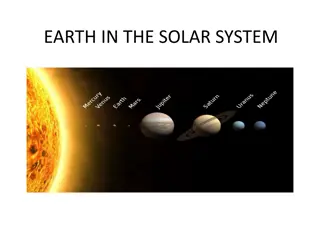Discovering Relativistic Outflows in Seyfert Galaxies
Anjali Gupta and collaborators discovered relativistic outflows in Seyfert galaxies Ark 564 and Mrk 590, with low-velocity outflows being common in these galaxies. The presence of warm absorbers and unidentified flying objects (UFOs) with varying properties have also been observed, shedding light on the dynamic processes within these galaxies.
Download Presentation

Please find below an Image/Link to download the presentation.
The content on the website is provided AS IS for your information and personal use only. It may not be sold, licensed, or shared on other websites without obtaining consent from the author.If you encounter any issues during the download, it is possible that the publisher has removed the file from their server.
You are allowed to download the files provided on this website for personal or commercial use, subject to the condition that they are used lawfully. All files are the property of their respective owners.
The content on the website is provided AS IS for your information and personal use only. It may not be sold, licensed, or shared on other websites without obtaining consent from the author.
E N D
Presentation Transcript
Discovery of Relativistic Outflows in the Seyfert Galaxies Ark 564 and Mrk 590 Anjali Gupta Columbus State Ohio State University Collaborators: Smita Mathur, Yair Krongold
Low velocity outflows are ubiquitous Seen in 50% of Seyfert galaxies. NGC 3783 HST and FUSE
Warm Absorbers Log = 0 2 erg s-1 NH = 1020 - 1022 cm-2 Outflow Velocity 100 1000 km s-1 Krongold et al. 2003
Warm Absorbers LIP: a low ionization parameter component, Fe UTA, UV lines HIP: a high ionization parameter component, seen only in X-rays In pressure equilibrium Not efficient agents of feedback Krongold et al.2003, 2007; Netzer et al. 2003
Discovery of UFOs In PG1211+143: Pounds et al. 2003
UFOs Log = 3 6 erg s-1 NH = 1022 - 1024 cm-2 Outflow Velocity 0.1c 0.3c Tombesi et al. 2010
Kinetic Luminosity UFOs Warm Absorbers From Tombesi et al. 2013
Issues with detected UFOs Identified through blueshifted FeXXV and/or FeXXVI absorption lines only All in low resolution CCD spectra. Low significance absorption lines. Parameterization of the photoionized plasma becomes difficult
Discovery of Relativistic Outflows in the Seyfert Galaxies Ark 564 and Mrk 590 Gupta et al. 2013; 2014
Discovery of relativistic outflow in Ark 564 Velocity = 0.1c
.well fit with photoionization model Log = 1.25/0.65 erg s-1 NH = 1019.8/1020 cm-2 Outflow Velocity 0.105c/0.103c
Relativistic outflow in Mrk 590 V = 0.081c - 0.176c
.and its photoionization model HV-LIP Log = 2.24 erg s-1 NH = 1020.94 cm-2 Outflow Velocity = 0.176c HV-HIP Log = 4.5 erg s-1 NH = 1023.5 cm-2 Outflow Velocity = 0.0867c/0.0738c
Kinetic Luminosity of Relativistic Outflows HV-LIP Kinetic luminosity > 1041 erg/s HV-HIP Kinetic luminosity > 1044 erg/s c.f. X-ray luminosity: 7.0 x 1042 erg/s
This IS a remarkable discovery! Relativistic outflows known only in luminous quasars -- BALQSOs in UV -- Few in hard X-rays: Fe line First example in soft X-rays: Robust! -- better instrumental response -- multiple lines at the same velocity Physical parameters well determined.
Disk-wind models of AGNs Proga & Kallan 2004
What is the driving mechanism? Radiation pressure doesn t work Magneto-hydrodynamics? Failed jets? New Physics Thank You Thank You
Theoretical Models King (2012) shock wind models produce winds with velocities v 0.1c, but in quasars accreting at Eddington limits. In this model a high velocity ionized outflow collides with the ISM of the host galaxy, losing much of its energy by efficient cooling resulting in a strongly shocked gas. The magneto-hydrodynamic accretion-disk wind models of Fukumura et al. (2010a;b) predict high-velocity (vout 0.6c) outflows. These models, how-ever, explain only the high- ionization high-velocity outflows, similar tothose observed byTombesi et al. (2012). In these models, ultra-high velocities are produced when UV to X-ray spectral slope is steep ( OX 2), i.e. the AGNs are relatively UV bright (or X- ray faint).
What is the distance of the absorber from the nucleus? Proposals span a factor of > 106 from accretion disk to Kpc scale narrow line region n R2
Variability Density Distance
XMM Observations of NGC 4051 RGS High resolution spectrum EPIC Variability Krongold et al. 2007
Energy outflow rates Kinetic power released: ~1038 erg/s c.f. bolometric luminosity: 2.5 x 1043 erg/s Energy injection rate in the surrounding medium is significantly smaller than that in feedback models Scannapieco Silk























